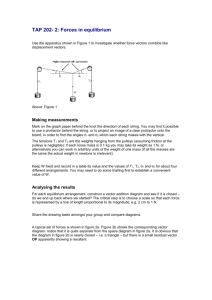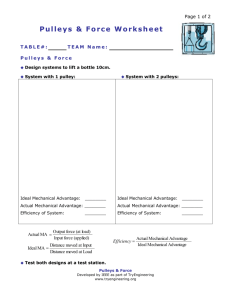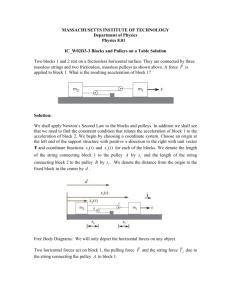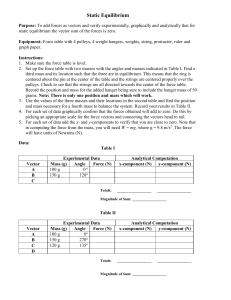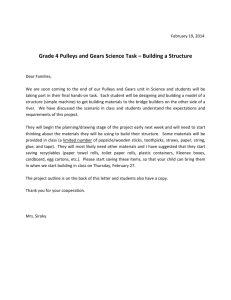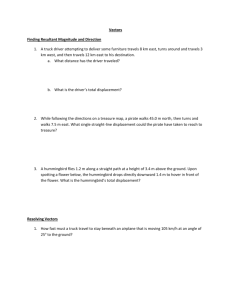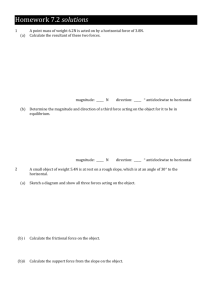P2: Forces and Equilibrium
advertisement
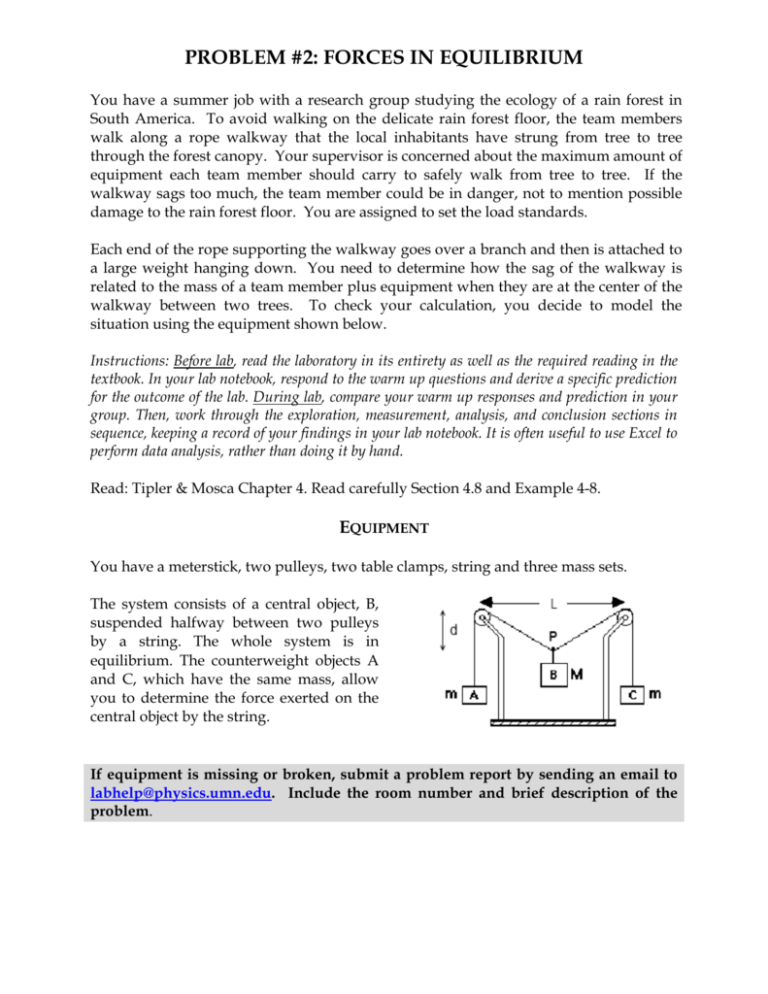
PROBLEM #2: FORCES IN EQUILIBRIUM You have a summer job with a research group studying the ecology of a rain forest in South America. To avoid walking on the delicate rain forest floor, the team members walk along a rope walkway that the local inhabitants have strung from tree to tree through the forest canopy. Your supervisor is concerned about the maximum amount of equipment each team member should carry to safely walk from tree to tree. If the walkway sags too much, the team member could be in danger, not to mention possible damage to the rain forest floor. You are assigned to set the load standards. Each end of the rope supporting the walkway goes over a branch and then is attached to a large weight hanging down. You need to determine how the sag of the walkway is related to the mass of a team member plus equipment when they are at the center of the walkway between two trees. To check your calculation, you decide to model the situation using the equipment shown below. Instructions: Before lab, read the laboratory in its entirety as well as the required reading in the textbook. In your lab notebook, respond to the warm up questions and derive a specific prediction for the outcome of the lab. During lab, compare your warm up responses and prediction in your group. Then, work through the exploration, measurement, analysis, and conclusion sections in sequence, keeping a record of your findings in your lab notebook. It is often useful to use Excel to perform data analysis, rather than doing it by hand. Read: Tipler & Mosca Chapter 4. Read carefully Section 4.8 and Example 4-8. EQUIPMENT You have a meterstick, two pulleys, two table clamps, string and three mass sets. The system consists of a central object, B, suspended halfway between two pulleys by a string. The whole system is in equilibrium. The counterweight objects A and C, which have the same mass, allow you to determine the force exerted on the central object by the string. If equipment is missing or broken, submit a problem report by sending an email to labhelp@physics.umn.edu. Include the room number and brief description of the problem. FORCES IN EQUILIBRIUM – 1301Lab3Prob2 WARM UP It is useful to have an organized problem-solving strategy such as the one outlined in the following questions. You can refer to the problem Force and Motion if needed (where a more detailed set of Warm up questions is provided) to solve this problem. 1. Draw a sketch of the setup. Draw vectors that represent the forces on objects A, B, C, and point P. Use trigonometry to show how the vertical displacement of object B is related to the horizontal distance between the two pulleys and the angle that the string between the two pulleys sags below the horizontal. 2. The "known" (measurable) quantities in this problem are L, m and M; the unknown quantity is the vertical displacement of object B. 3. Write down the acceleration for each object. Draw separate force diagrams for objects A, B, C and for point P (if you need help, see your text). Use Newton’s third law to identify pairs of forces with equal magnitude. What assumptions are you making? Which angles between your force vectors and your horizontal coordinate axis are the same as the angle between the strings and the horizontal? 4. For each force diagram, write Newton's second law along each coordinate axis. 5. Solve your equations to predict how the vertical displacement of object B depends on its mass (M), the mass (m) of objects A and C, and the horizontal distance between the two pulleys (L). Use this resulting equation to make a graph of how the vertical displacement changes as a function of the mass of object B. 6. From your resulting equation, analyze what is the limit of mass (M) of object B corresponding to the fixed mass (m) of object A and C. What will happen if M>2m? PREDICTION Write an equation for the vertical displacement of the central object B in terms of the horizontal distance between the two pulleys (L), the mass (M) of object B, and the mass (m) of objects A and C. EXPLORATION Start with just the string suspended between the pulleys (no central object), so that the string looks horizontal. Attach a central object and observe how the string sags. Decide on the origin from which you will measure the vertical position of the object. FORCES IN EQUILIBRIUM – 1301Lab3Prob2 Try changing the mass of objects A and C (keep them equal for the measurements but you will want to explore the case where they are not equal). Do the pulleys behave in a frictionless way for the entire range of weights you will use? How can you determine if the assumption of frictionless pulleys is a good one? Add mass to the central object to decide what increments of mass will give a good range of values for the measurement. Decide how measurements you will need to make. MEASUREMENT Measure the vertical position of the central object as you increase its mass. Make a table and record your measurements with uncertainties. ANALYSIS Graph the measured vertical displacement of the central object as a function of its mass. On the same graph, plot the predicted vertical displacement. Where do the two curves match? Are there places where the two curves start to diverge from one another? What does this tell you about the system? What are the limitations on the accuracy of your measurements and analysis? CONCLUSION What will you report to your supervisor? How does the vertical displacement of an object suspended on a string between two pulleys depend on the mass of that object? Did your measurements of the vertical displacement of object B agree with your predictions? If not, why? State your result in the most general terms supported by your analysis. What information would you need to apply your calculation to the walkway through the rain forest? Estimate reasonable values for the information you need, and solve the problem for the walkway over the rain forest. FORCES IN EQUILIBRIUM – 1301Lab3Prob2
